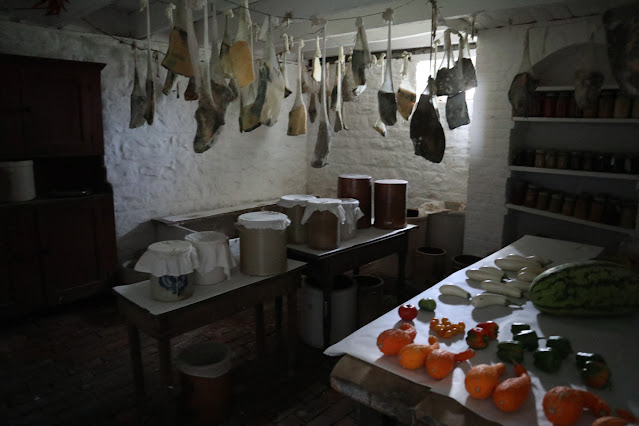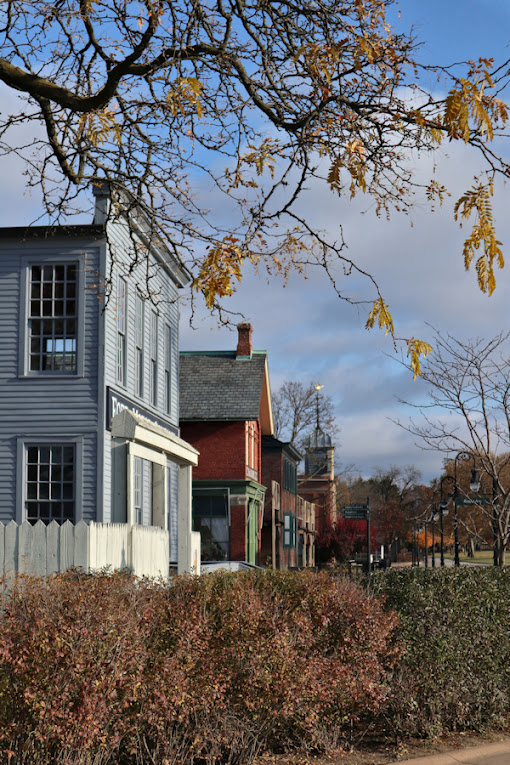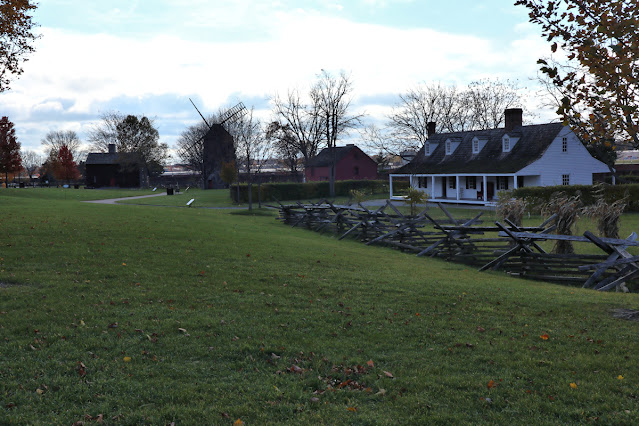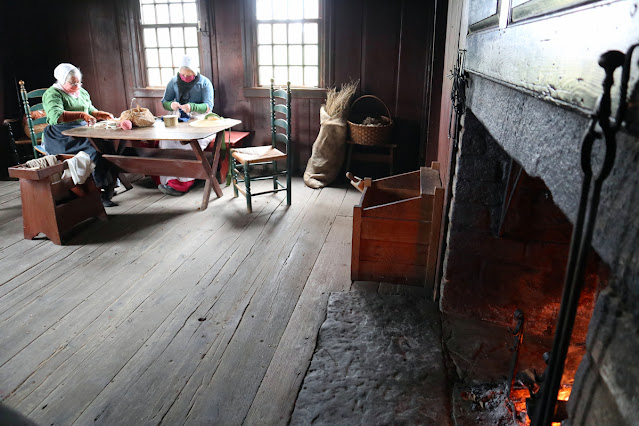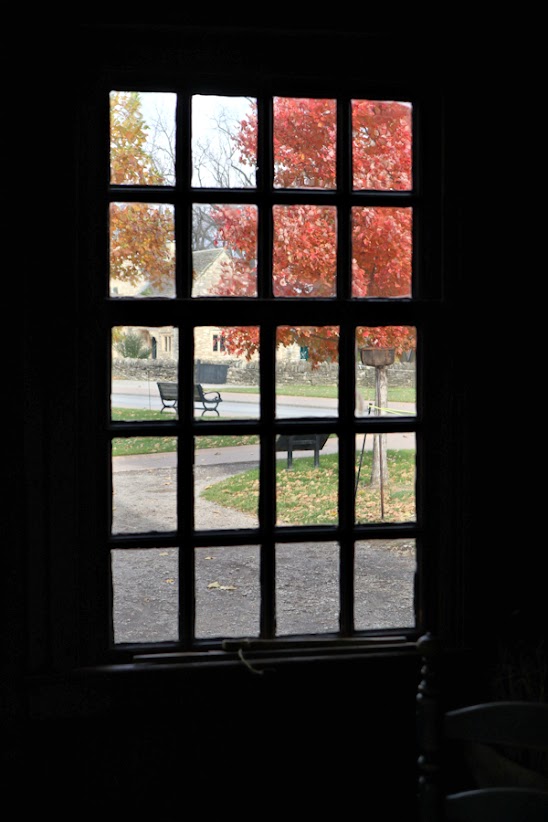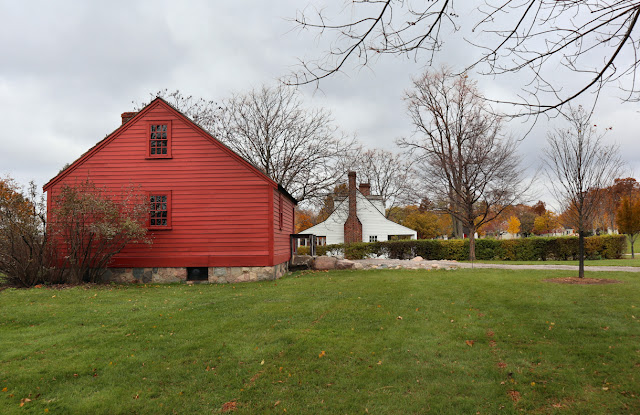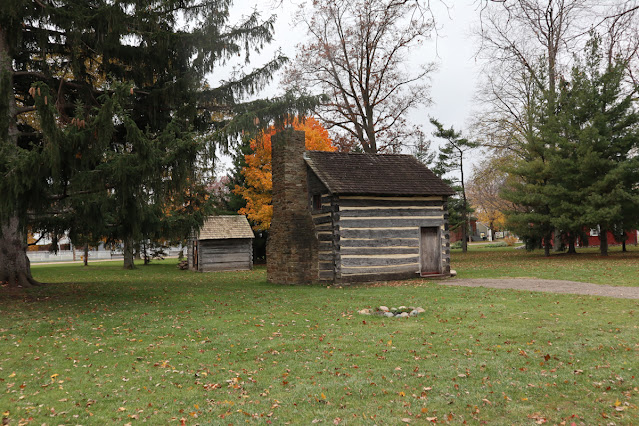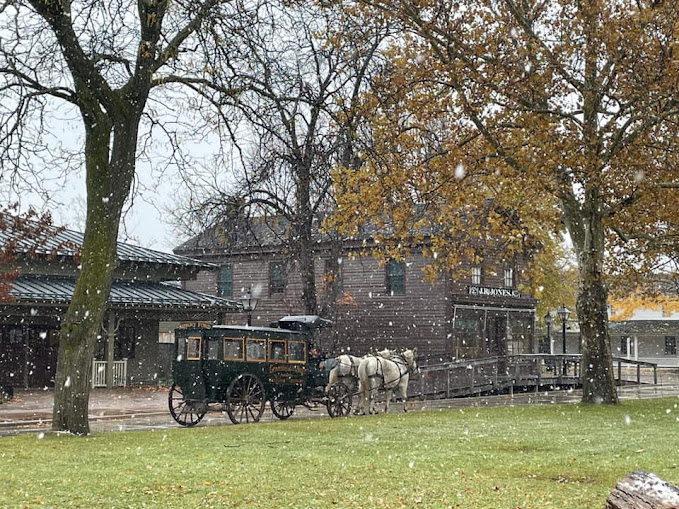 |
One of my hats and my cloak.
It was a cool morning on this day. |
The term "Living Historian" is often misapplied to anyone who attempts to convey information about the past while dressed in period clothing. However, Living History, by definition, is an activity that incorporates not only period clothing, but historical tools and activities into a living, breathing history-book-come-to-life that seeks to give participants and observers a sense of stepping back in time, usually through action. Although living history does not necessarily seek to reenact a specific event in history, such as a particular battle or a famous speech, it is similar to, and sometimes incorporates, historical reenactment.
It is important to note, however, that while living historians can "reenact," not all re-enactors make good living historians. Dressing in period clothing and engaging in period activities allows re-enactors to "experience" as well as teach the past. Living historians, on the other hand, can usually be associated with historical sites and museums that specialize in interpreting the past through a format that allows visitors to visualize a time long ago through the use of their senses.
Whether one is a living historian, a reenactor, or both (as I try to be), all are important in bringing the past to life.
~ ~ ~
 |
Charlotte, Jackie, Larissa, and myself.
We make a great living history team. |
So it was a year ago when we utilized the colonial frontier cabin for our first time in a living history manner, for while we were there we threshed wheat, cut down a tree with an axe, and processed flax. We also had a wonderful harvest meal cooked over the hearth. However, I wasn't sure if I was able to take part in any fall activities this year, due to a severe health situation. But, as a blessing, here I am with my good friends, back at the cabin, where we spent a beautiful autumn day - November 6 - in the frontier cabin at Historic Waterloo Farm in Munith, Michigan For those of us who participated - besides myself we had Larissa, Jackie, and Charlotte - it was 1771. This year we took it a bit easier, for I am still somewhat weak and I did not want to overdo anything and find myself in a dire health situation once again.
Hence - candle making.
As part of their domestic work, women, with help from children and the elderly or infirm, usually were the ones who carried the entire candle making process from start to finish. So rather than do any of the more strenuous harvest chores that could have easily over exerted me, I decided that I, as one who was recuperating (or infirm), would take part in this less strenuous chore.
 |
| You see the fire to make candles to the left there. |
Let's begin, then, with a bit of social history and thoughts on this art of candle dipping:
Most 18th and 19th century homes were as self-sufficient as they could be and those who lived in them did their best to produce as many things needful to life as they could, and this did include candles. This is not to say that items such as candles could not be purchased or bartered for. Oftentimes they were. But for today's posting we are going to look upon the home that produced their own artificial light, for that is what we spent this day doing. Remember, though - there are always exceptions to nearly everything.
An interesting side note is how reenactors react during power outages; our candles and oil lamps are generally more easily accessible than flashlights. In fact, many times I've used candle light to search for my flashlight or flashlight batteries.
Needless to say, going to the bathroom becomes infinitely more interesting, and can be a chore; we are so used to high brightness that it's almost eerie without.
To head to the basement to get more paper towel? Bring a candle with you. Want to change into your night clothes? Have that oil lamp setting near your dresser. Need to get a drink of water from the kitchen? Make sure to bring your light.
The funny thing is, during these blackouts I still habitually reach for the light switch whenever I enter a darkened room.
You, too?
 |
Sitting in the November sunshine, waiting for
the beeswax to melt.
 | Not as much wax as I thought I had, but all you see here is pure beeswax
including the white bars.
(Unfortunately, after I returned to my modern home, I found a large
block of wax I had forgotten about in my basement.
Oh well - more for next year!) |
 | Here you see "our" cabin - we are so very thankful to be able to utilize it in
such a manner that we make it our 18th century home.
Still waiting for the wax to melt - it's a long process to make homemade lighting!
At least it was a beautiful fall day. |
|
But I was surprised to find how many candles one can go through during an outage; we do try to conserve, as did the folks in days of old, by only using one or two candles in whatever room we are in, with the second light usually for "traveling" around the house. Making candles is a long process from start to finish - no wasting of candlelight in my house!
One definite lesson I learned about candle comparisons: the 12" long tapered candles I used to buy at the store burn nearly three times as fast as the 6" to 7" beeswax candles I dip myself. One beeswax candle almost half that size can burn for five hours or more, while the longer modern store-bought one lasts maybe two or three hours at most.
This was confirmed by Tom Redd, a Materials Analyst for the Foundation in Colonial Williamsburg: “Let us imagine we have four candles, and each one is about three-quarters of an inch in diameter and they are all about 10 inches long. They are in a room where the air is still. A candle well-made of the best tallow (beef fat) might burn two hours. A bayberry candle might last eight, while a beeswax candle may burn for 10 hours. The finest candle, imported from New England, would have been made of spermaceti wax. Spermaceti is taken from the head of the sperm whale. The spermaceti candle might last 12 hours or more, and burn with a brighter light.”
 |
I like this type of photograph...
|
Idle hands are the devil's workshop, as the saying goes.
No idle hands here as we wait for the wax to melt:
 |
While waiting for the wax to melt, Charlotte and Larissa
walked around and picked up the many black walnuts
on the ground to be used for dyeing wool a deep brown.
 |
Artificial light in the 18th century was truly a luxury. Unlike what you see in the TV shows based in history such as "Outlander" or "Turn: Washington's Spies," people were used to working by daylight while indoors, so lighting a candle when the sun was up rarely, if ever, happened, much less seeing a dozen or more lit "as seen on TV." It was customary for folks to move from room to room to get the most out of the day's light. Generally, candles were lit only during the nighttime hours, and sparingly so, due to the lengthy candle-making process. According to one of the chandlers I spoke to at Colonial Williamsburg, a typical middle class home in the 1750's could go through nearly 500 to 700 candles a year. And that may even be a conservative amount for some.
However, for folk like us living in a cabin, we may go through far less - - perhaps only 300 or so, for we only have the one room, plus the hearth would be used for lighting as well. You see, firewood is much easier to come by out on the frontier.
 |
| Building up the fire. |
Though it can be done any time of year (as long as there are supplies), the usual period for making candles is in early-to-mid November. It has to be just cold enough for quick hardening, and follow shortly after fall hunting, where the collected waste fat from the butchered animals is used to make tallow for dipping. Tallow candles were very popular in the 18th century, and due to the idea that rendered lard is many times easier to obtain than beeswax, it was much more common, especially out on the farm (city folk can purchase their candles from the chandler, if need be).
Since we did not have any fat, we had no tallow. I do hope to do tallow candle dipping sometime.
But we did have pure beeswax. Farmers would have beehives on their property to help ensure a good growing season. With bees comes wax...and honey, a wonderful sweetener rather than purchasing expensive sugar.
By the way, it is not necessarily true that when the sun went down so did the people. Perhaps in the summertime when the sun remained in the sky much later, but definitely not in the colder months of fall and winter, especially, when the sun went down before 5:00 in the afternoon - they did not go to bed so early. That's what artificial lighting, such as candles, was for.
Such myths need to stop being spread!
 |
Ah!
Finally the wax had melted and we can begin to dip the wicking,
which was tied three and four to a stick, into the pot, careful not to get the
hot wax on our fingers (ha!). |
It must be remembered that in those days of old candle making was not the fun hobby as it is in our modern times; it was a backbreaking, smelly, sometimes greasy task. The making of the winter's stock of candles was the special autumnal household duty, and a hard one, too, for the large kettles were tiresome and heavy to handle, and as I mentioned earlier, the work was well under way at a very early hour, with the temperatures being just cold enough for quick hardening.
Wicks were made from linen thread, cotton, hemp, or, less often, from milkweed. If one lived near a general store, or perhaps if a peddler happened by, thick string could be bought to use as wicks.
 |
My back ached, for it took anywhere from 30 to 40 dips, depending on how
thick one likes their candles to be, to make a decent sized candle. |
During candle-making time, an early hour found the work well under way for our ancestors. If done indoors, a good fire was started in the kitchen fireplace under two vast kettles, which were hung on trammels from the crane, and half filled with boiling water and melted beeswax or tallow.
At the far end of the kitchen or in an adjoining and cooler room, sometimes in the lean-to, two long poles were laid from chair to chair or stool to stool. Across these poles were laid candle rods, which were about a foot and a half long, and to each rod was attached about six to eight carefully straightened candle-wicks. With the fat/tallow or wax in the pot melted, the wicking from the rods would be dipped into the pot and then returned to its place across the two poles. This process would occur repeatedly as each rod was dipped into the tub of tallow or wax, and with each dip the candles became larger and larger until the desired length and width was had.
Now, as you can see, we did our chore outdoors, as many of the time also did in such fine fall weather.
 |
What you see me doing here is putting the freshly and still hot dipped wicks into
a pot of cold water to cool them down quickly for doing another dip in the wax.
By cooling them down and immediately wiping them dry allows for quicker dipping.
Now, understand, they didn't necessarily do it this way back in the day - they would
have numerous rods with wicks/candles to dip, so by the time the first-dipped came
around for the next layer of wax, it would have dried on its own. |
We spoke next year of trying it in the more traditional non-water manner next year. The more traditional, the better.
It's here that we can quote Susan Blunt, who remembered her 18th century mother during the fall candle dipping season:
"Mother used to dip candles in the fall, enough to last all winter. When a beef was killed in the fall, she would use all the tallow for candles. On the evening before, we would help her prepare the wicks. The boys would cut a lot of rods and she would cut the wicks the length of a candle and then string them on the rods.
"In the morning she would commence her day's work. She would dip each one in the hot tallow and straighten out the wicks so the candles would be straight when they were finished. By raising the candles (out of the kettle) at just the right speed and working on a day with a moderate temperature, the fine quality of the candles would be assured. The candles would be cooled overnight and the bottom ends cut off neatly. The finished candles were packed away in a mouse-proof container for safe storage."
 |
Not quite done yet!
A few more dips to go.
|
And the diary of Martha Ballard tells us:
November 5, 1787
"Clear & pleast. I Came from mr Fosters. we made 25 Dozn of Candles."
Twenty five dozen - that's 300 candles in one day! Methinks that would've been all we would have needed!
 |
With the food cooking in the hearth, all four of us spent time making candles.
|
Next we have a wonderful example of candle-making from the Laura Ingalls Wilder book, "Farmer Boy." Wilder writes of Almanzo's mother making candles, also from tallow. As I said earlier, one day I hope to make tallow candles even though the basic motions are the same with using beeswax:
"The end of butchering time was candle making. Mother scrubbed the big lard kettles and filled them with bits of beef fat. Beef fat doesn't make lard; it melts into tallow. While it was melting, Almanzo helped string the candle molds. A candle mold was two rows of tin tubes, fastened together and standing straight up on six feet. There were twelve tubes in a mold. They were open at the top, but tapered to a point at the bottom, and in each point there was a tiny hole. Mother cut a length of candle-wicking for each tube. She doubled the wicking across a small stick, and twisted it into a cord. She licked her thumb and finger and rolled the end of the cord into a sharp point. When she had six cords on the stick, she dropped them into six tubes, and the sticks lay on top of the tubes. The points of the cords came through the tiny holes in the points of the tubes, and Almanzo pulled each one tight, and held it tight by sticking a raw potato on the tube's sharp point.
When every tube had its wick, held straight and tight down its middle, Mother carefully poured the hot tallow. She filled every tube to the top. Then Almanzo set the molds outdoors to cool. When the tallow was hard, he brought the mold in. He pulled off the potatoes. Mother dipped the whole mold into the boiling water, and lifted the sticks. Six candles came up on each stick. Then Almanzo cut them off the stick. He trimmed the ends of wicking off the flat ends, and he left just enough wicking to light, on each pointed end.
All one day Almanzo helped mother make candles. That night they had made enough candles to last til butchering time next year."
This year I did not use any of my molds, but when I do that is exactly how I removed the candles from the tubes.
 |
| No molds - just dipping...and dipping...and dipping...30 to 40 times for each rod. |
Our ancestors did live in darker times, as we in the modern day find out when a power outage strikes; we are so used to having bright electric lights, day or night, that sometimes even sunlight coming through a window isn't bright enough for some - they'll still turn on their electric light.
Just like lighting candles during the day! Lol!!
There are also those who feel - have proven, to some extent - that the harshness of the modern electric light plays greatly upon our moods and emotions:
~excessive artificial lighting can cause us to feel nervous and on edge
~uncovered globes and lamps without shades can cause us to feel irritated
And common sense can tell us of the relaxation received upon entering a candle lit room. When friends visit our home on a fall or winter evening, the candles we use for lighting bring a smile to their faces...every time.
Even the kids.
And natural lighting through windows has calming effects on our emotions as well.
 |
Although this was not a public event, we had a visitor "from the future" stop by.
She saw us from the road and just had to see what we were doing.
I put her to work taking pictures of all four of us!
 |
I remember early on in the relationship between my wife and I...back in our dating days. We would visit historic places like Greenfield Village and Crossroads Village and simply ogle at the period crafts that the presenters would do, such as spinning on a spinning wheel, dye wool, make colonial beer, plow behind horses, make 19th century ice cream, and, yes, even make candles.
"Wouldn't it be cool to be able to do this?" we would say to each other.
More recently we were watching one of those excellent British farming shows where the presenters actually live on a period farm utilizing only the amenities of the era, and we both realized that we have pretty much done so many of the period chores, crafts, and activities of what we spoke on doing all those years ago.
We have made 19th century ice cream. I have plowed behind a team of horses. Patty spins wool into yarn on a spinning wheel. I've helped make 18th century beer. Patty has dyed wool "naturally."
And we make our own candles.
It would be quite a list if I wrote down all the period things we've done.
Thanks to our venture into reenacting...and living history.
 |
We all really enjoyed this chore.
I was sorry I did not have more wax to keep it going. |
Yet, we are not done. There are more historical everyday life activities I/we have yet to try. Not just my wife and I, but my friends - my living history friends...the wonderful folk you see me with here...and a few others.
The key is, I insist doing it all while wearing period clothing - it just sort of authenticates it, you know? I mean, anything can be done in your modern clothing, but once you are in the fashions of the past, it truly does make a world of difference, not only for the wearer but for those watching as well.
 |
| Various stages of candle dipping. |
On this November day we dipped a total of 40 candles. Now, to be fair, we began the process closer to 11:00 in the morning rather than at a very early hour such as at daybreak, and we ended the process in mid-afternoon rather than at sunset (we ran low on wax). Had we gotten to the cabin much earlier, and had we had more wax, we would have more than doubled the amount of candles made.
So 40 candles isn't horrible, but to keep up with, say, around 400, at this rate we would be dipping for 10 days.
 |
| The candles that we dipped on November 6th. |
Next year we'll do better!
As mentioned before, making candles wasn't the only 18th century job that was done during our time at the cabin. We needed to eat, and cooking stoves as we know them to be were still decades in the future, so the ladies of the house put together a traditional 1770s meal to be cooked on the open hearth.
 |
| Larissa and Jackie preparing a fine 18th century dinner. |
 |
Larissa is a master at cooking on the hearth. She has been doing it at the
1750 Daggett House (located in historic Greenfield Village) for around 25 years,
so, yes, she does know a thing or two about it!
|
 |
| Charlotte also played a role in the culinary arts here. |
 |
| Charlotte was getting her brazier to light by using a blow pipe. |
 |
The sun beating on the floor helped to warm up the cabin even though it was
only in the upper 40s outside. |
 |
Larissa made fricandillas, which is an 18th century meatball recipe.
So good! |
Here in the next picture we see a Dutch oven in use (that's the black pot with the pie inside). Notice the coals on top of the lid as well as below the pot. It's done that way in order to bake the pie more evenly.
By the way, this pot was also referred to as a "bake kettle."
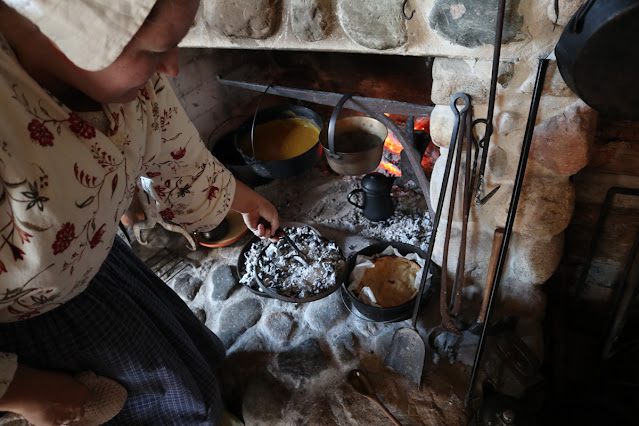 |
| For dessert, apple pie! |
Running a kitchen really did require a staggering range of skills, including chopping kindling, keeping a fire burning indefinitely, knowing which wood was best for baking or frying, plucking feathers from fowl, butchering animals large and small, cosseting (caring for) bread yeast, brewing beer, making cheese, adjusting 'burners' of coals on a hearth and gauging the temperature of a bake oven. In fact, the colonial cook would have to begin their work by "building a good-sized fire on the hearth, but once the logs had burned to coals, the embers were moved around, and carefully selected pieces of wood would be added to produce different kinds of heat, often having several small fires going at once. Piles of live embers on the hearth were like burners on a stove; a gridiron set over a pile of coals could be used for broiling; a pan set over coals on a trivet could be used for frying; and coals could be piled over and under a Dutch oven for baking."
(From the book America's Kitchens by Nancy Carlisle and Melinda Talbot Nasardinov).
 |
Swinging iron arms protruding from the surrounding stone or brick held massive pots, enabling the cook the luxury of moving the pots closer to or further from the fire, and Dutch ovens, setting on the hearth with coals underneath and on the lid, evenly baked cakes, pies, and other delights.
By the way, that's Charlotte's butternut squash soup in the large pot. |
Most cooking fireplaces were equipped with a suspension system for the large pots and kettles. An iron crane that could be swung out toward the room to check on the contents of the pots and kettles was also mounted inside of the chimney. By raising or lowering the pots to adjust the distance between them and the fire, or by moving the crane forward into the room, cooking temperatures could be adjusted.
 |
| Jackie prepared Rosemary Garlic bread. |
One of the things that has noticeably changed in recent times is how much actual time is spent in the kitchen today by modern cooks. With "innovations" such as microwaves, frozen "tv" dinners, pre-packaged foods, and fast food restaurants, the time and energy spent in this oh-so-important room is nowhere near what our ancestors did for food preparation.
Pride in cooking seems to have gone out the window as well.
 |
Our dining area, across from the fireplace.
It's a one-room cabin. |
 |
Charlotte, Larissa, and Jackie:
Many people believe that cooking on the hearth is like cooking over an open fire.
Well, all three of these ladies will tell you that is a wrong assumption.
Under the watchful eye of Larissa over the past year, Jackie and Charlotte
certainly received a wonderful lesson in historic cooking. |
 |
The colonial women who spent their time in the kitchen were nothing short of
culinary geniuses. |
 |
And since we had no one to take our dinner photo, Larissa took
one of the food we had to eat.
It was all excellent! |
 |
Jackie taking in the warmth of the sun.
As I wrote in a previous posting, sometimes just sitting
and listening to the sounds of the past, such as the period
shoes clumping on the old wood floor as the iron cookware
clangs in the fireplace brings one back in time as much
as eyesight can. |
 |
Bartering a jar of honey for candles.
|
It's true!
The woman who stopped by earlier to watch us make candles and took photos for us brought us a jar of homemade honey straight from her father's farm. We offered to pay her but the only thing she wanted was a candle.
She simply loved what we were doing - bringing history to life - and she so appreciated it.
That's why we don't mind a few visitors watching us, even if we're doing a more private event. We made her day, and she added to ours.
 |
Shaking out the bed quilts.
Well...one does not want to sleep with dirty blankets! |
 |
In the morning...good day sunshine.
Before the day's activities really took off, I wanted to get a group
photo with this beautiful tree of gold (that also had touches of red)
that shows the beauty of a Michigan autumn... |
And then...forever afternoon...
 |
...as the sun's rays began to wane, it seemed to just light
this tree on fire!
It was so beautiful! |
 |
The candles we dipped at the cabin
on the holder at my home. |
On our way back to the 21st century we spoke on other period crafts that we can do for future-past endeavors, such as soap making, dyeing wool with natural dyes, possibly making beer (if we will be allowed to), as well as continue to do some of the flax planting, growing, harvesting, and processing, spinning, cooking on the hearth, threshing, candle making, perhaps with tallow as well as beeswax, and other daily life activities of the 18th century.
And wouldn't it be fun to plow the flax field by way of horses?
Yeah...just a few of the many ideas we have come up with.
So, I think that's how we'll end this posting.
Making candles over an open fire with friends while wearing period clothing at the cabin on a perfect crisp fall day is a great tradition. These candles will be a bit extra special.
This was such a very fine way to spend a fall day indeed! And it sure does feel good to be on the mend after my illness last month! Thank you to my very good friends Larissa, Charlotte, and Jackie for convincing me to do this day of living history and for looking after me while there.
I appreciate you ladies more than you may realize. And not just for your cooking skills (lol)!
Until next time, see you in time.
To read about our 2020 autumn excursion at the cabin, click
HERETo read about our wintertime excursion at the cabin, click
HERETo read about our springtime excursion at the cabin, click
HERETo read about our summertime excursion at the cabin, click
HERETo read about harvesting the flax at the cabin, click
HERE
~ ~ ~













